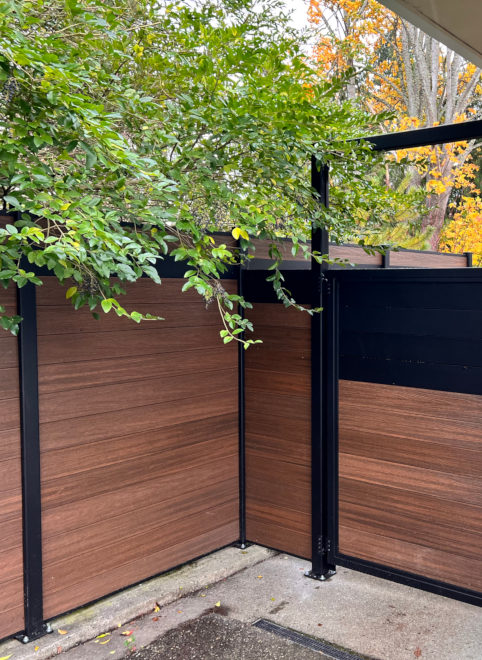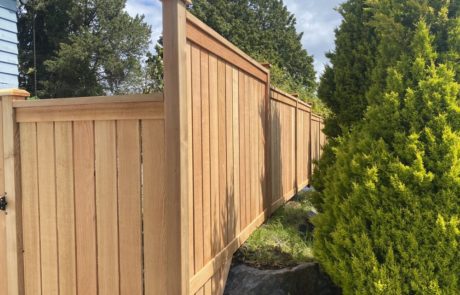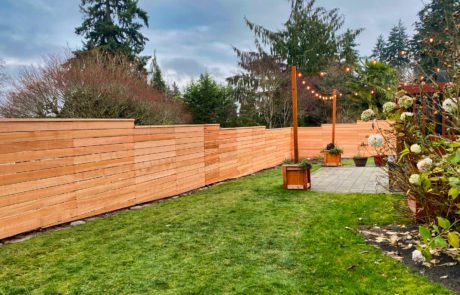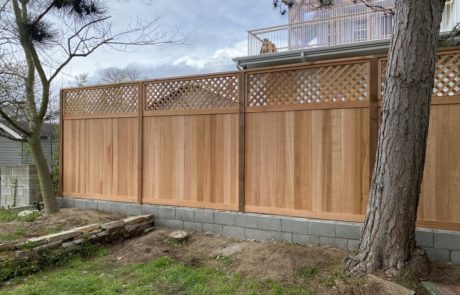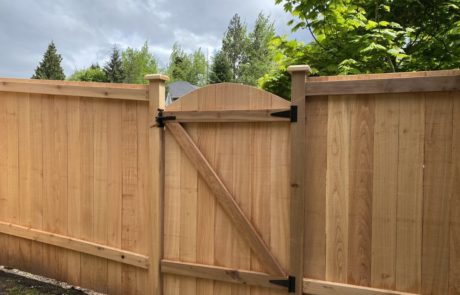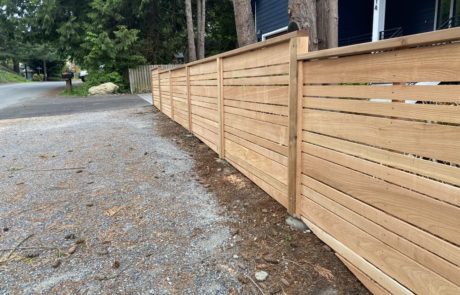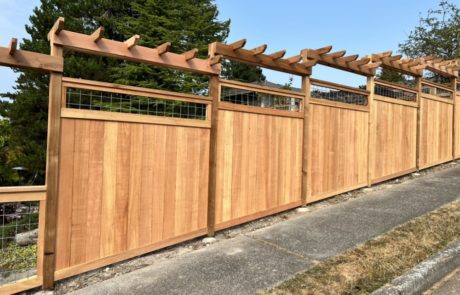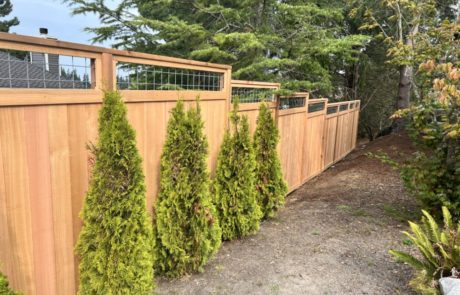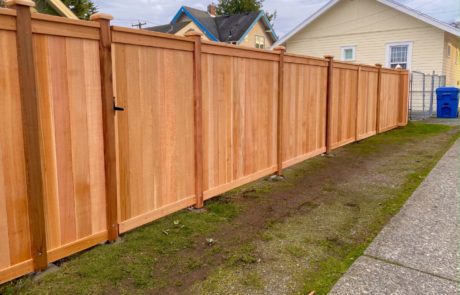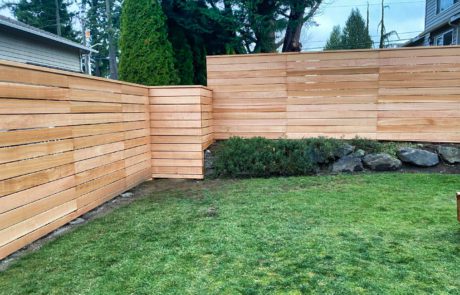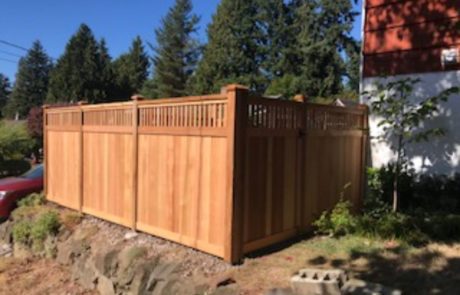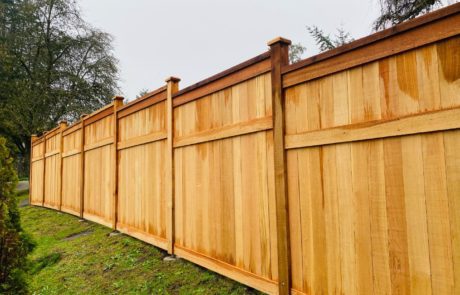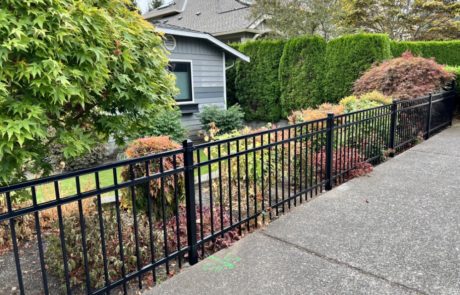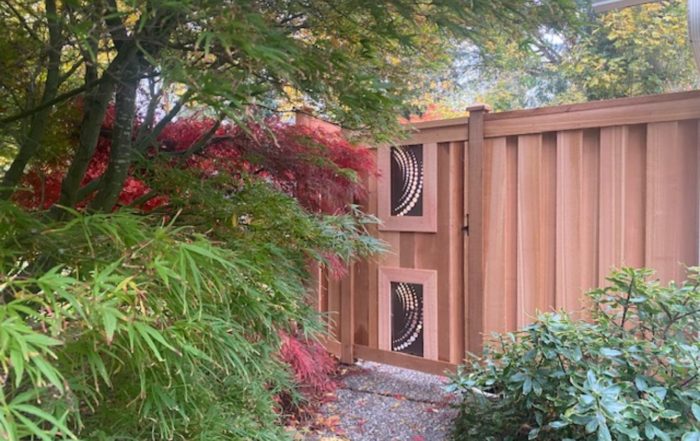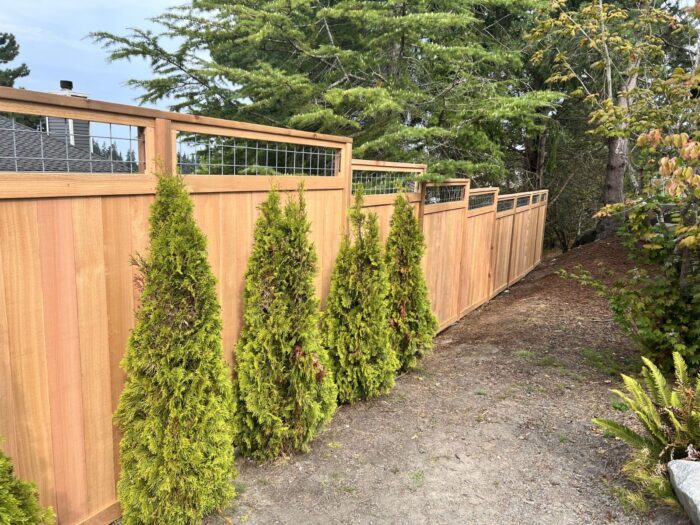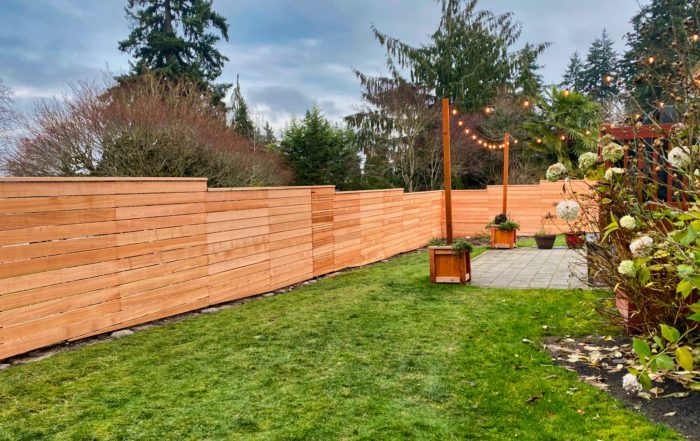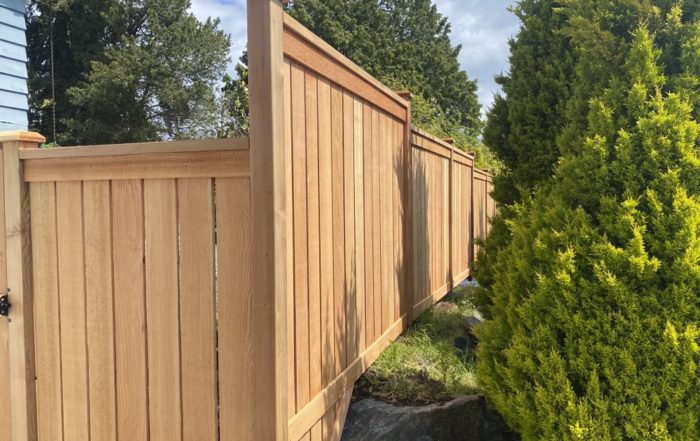If you’re weighing the merits of composite vs wood fence, critical factors dictate your choice: longevity, care, expense, and look. This guide cuts through the confusion to offer a clear breakdown, equipping you with everything you need to know to make a choice that stands the test of time and trends.
Key Takeaways
- Composite fencing is a durable and low-maintenance option made from recycled wood fibers and plastics that resists weather, pests, and decay, and can last 30-50 years if properly cared for.
- Wood fencing offers a natural and traditional look, with a variety of types and colors available, and is more budget-friendly but requires more maintenance and may last around 20 years.
- While composite fencing has a higher upfront cost, its low maintenance and longevity provide better long-term value, making it a cost-effective choice despite the initial investment.
Composite Fencing: Materials and Benefits

Composite fencing, a future-forward option, is a robust blend of recycled wood fibers and plastic. This unique combination provides a durable and low-maintenance alternative to traditional fencing, making composite wood fences an excellent choice.
Although composite fencing’s popularity is a relatively new phenomenon, it has rapidly emerged as a powerful contender in the fencing market, presenting a compelling alternative to traditional wood fences.
Material Composition
The key to composite fencing’s impressive strength and longevity is its unique composition. A mix of recycled wood fibers and thermoplastic polymers, such as polyethylene or polypropylene, creates a robust material that can withstand the rigors of the outdoors.
The fusion of organic and synthetic materials, such as plastic and wood fibers, provides the density and weather resistance of wood alongside the durability and resilience of plastic.
Manufacturing Process
The fusion of these materials into wood plastic composite fencing is achieved through the Wood Plastic Composite (WPC) manufacturing process, where wood fibers are mixed with polymer resins at high temperatures. This mixture is then shaped into panels or poured into molds to create a strong composite that mimics the look and feel of wood.
Unlike its natural counterpart, however, composite fencing showcases superior weather and pest resistance, ensuring a product that lasts longer and requires less maintenance.
Key Benefits
What makes composite fencing a worthy choice? The answer is its manifold benefits. An amalgamation of recycled plastic, reclaimed wood fibers, vinyl, and recycled plastics gives composite fencing its renowned strength and longevity. Some of the benefits of composite fencing include:
- Lasting from 30-50 years, and top-tier options can even surpass the half-century mark
- Resistant to rot, decay, and insect damage
- Low maintenance, requiring no painting or staining
- Environmentally friendly, made from recycled materials
- Available in a variety of colors and styles to suit any aesthetic
With all these benefits, it’s no wonder that composite fencing is becoming a popular choice for homeowners.
This durability is further complemented by its low maintenance requirements. With composite fencing, you can say goodbye to the constant upkeep associated with wooden fences and enjoy more time in your outdoor oasis.
Wood Fencing: Materials and Benefits
In contrast, we find the timeless classic in fencing—wood. Universally loved for its natural, rustic charm, wood fencing offers a sense of warmth and tradition that composite fencing can’t quite replicate.
Whether it’s a quaint picket fence or a robust privacy fence, nothing quite matches the natural beauty of wood.
Types of Wood
Much like a painter’s palette, wood fencing is teeming with options. From the rich, reddish hues of cedar and redwood to the golden tones of pressure-treated pine, there’s a type of wood to suit every aesthetic preference and budget. Each type of wood offers unique benefits, such as cedar’s natural resistance to rot and insects, thanks to its natural oils, and the improved durability of pressure-treated lumber, which has been fortified with preservatives.
Key Benefits
The allure of wood fencing, however, goes beyond its aesthetic appeal. It’s a budget-friendly option that doesn’t compromise on quality or durability. With proper care and maintenance, a wooden fence can easily last for over 20 years, and some types of wood can even endure for up to 50 years.
Furthermore, its versatility in design is unmatched, with wood easily shaped into various styles, from classic picket fences to rustic split rail fence designs.
Durability Comparison: Composite vs Wood Fence
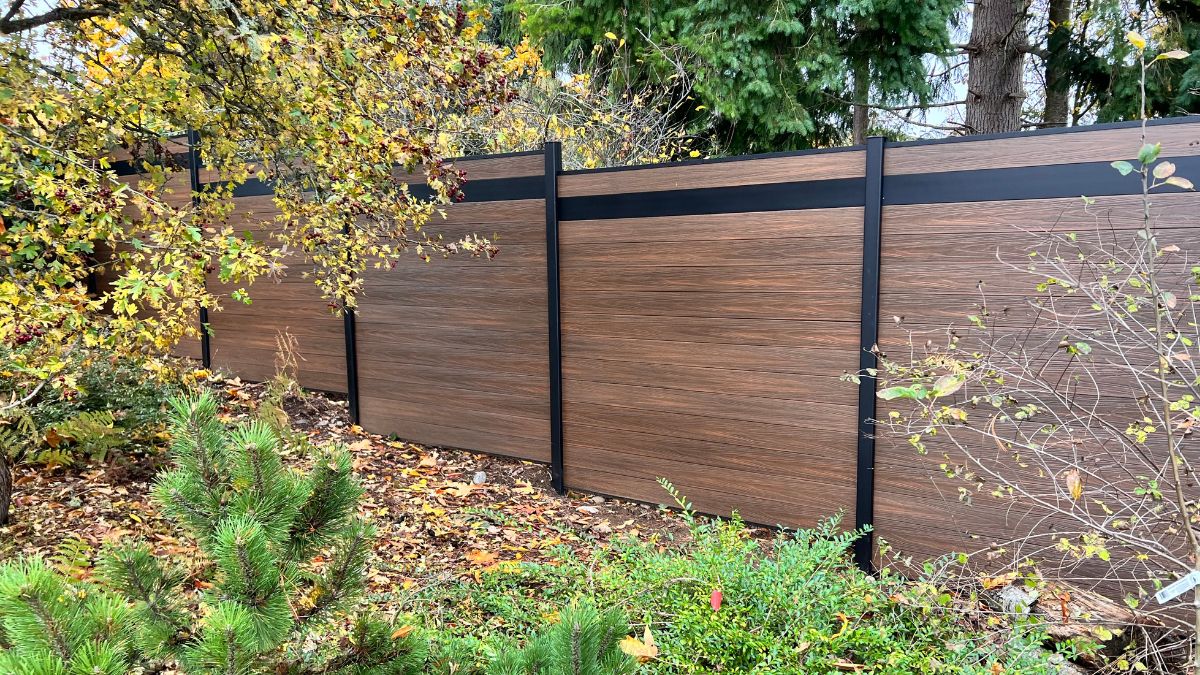
Infinity Euro Composite Fence
Composite fencing excels when faced with the elements and pests. Thanks to its unique material composition, it is more durable and long-lasting than traditional wood fencing.
How does the performance of these two contenders compare in terms of weather resistance, pest resistance, and longevity?
Weather Resistance
Whether you live in a region with sizzling summers or frigid winters, the performance of your fence in different weather conditions is crucial. Composite fencing, with its blend of wood fibers and recycled plastic, is designed to withstand the toughest weather conditions.
From relentless sun to pouring rain, composite fencing stands strong, resisting rot, warping, and fading.
Pest Resistance
If you’ve ever had to deal with the destructive prowess of termites or other wood-boring insects, you’ll appreciate the pest-resistant qualities of composite fencing. Unlike wood, composite materials do not attract insects, making it less prone to pest infestations.
Longevity
In terms of longevity, composite fencing outlives its wooden counterparts. With a lifespan stretching up to 50 years, composite fencing is a long-term investment that pays off in durability. In contrast, even the best-maintained wooden fences typically last 20 years—still a respectable lifespan, but not quite in the same league as composite fencing.
Cost Analysis: Initial Investment and Long-Term Expenses
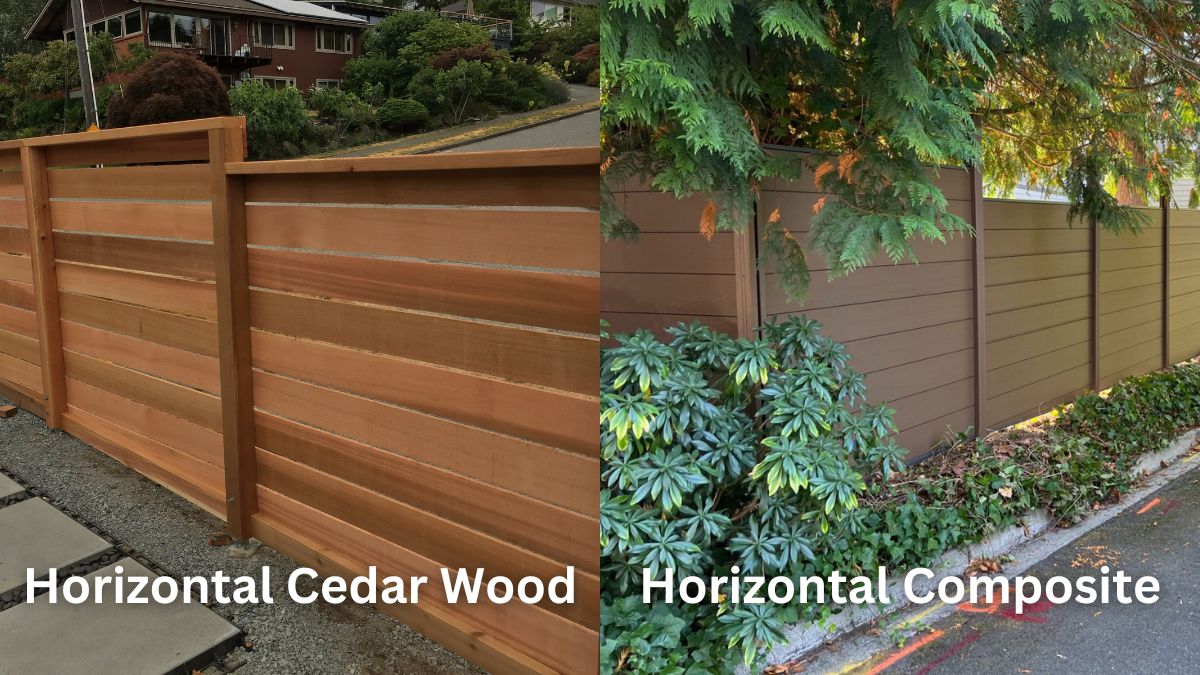
Both composite and wood fencing hold financial advantages. Here are the key points to consider:
- Composite fencing may have a higher initial cost
- Composite fencing has lower maintenance requirements
- Composite fencing has a longer lifespan
- These factors make composite fencing a cost-effective choice in the long run
On the other hand, wood fencing offers affordability upfront, although it requires more regular maintenance.
Initial Costs
At the outset, composite fencing tends to be more expensive than its wooden counterpart. However, this initial cost is offset by its durability and low-maintenance nature, which can result in cost savings over time.
Maintenance Costs
When it comes to maintenance costs, composite fencing once again has the upper hand. It requires less upkeep than wood fencing, translating to lower long-term costs.
Overall Value
While wood fencing may be the less costly option initially, composite fencing offers better long-term value. Thanks to its durability and low maintenance requirements, composite fencing proves to be a more cost-effective choice in the long run, despite the higher initial cost.
As the saying goes, “you get what you pay for,” and with composite fencing, you’re paying for quality and longevity.
Maintenance Requirements: Composite vs Wood Fence
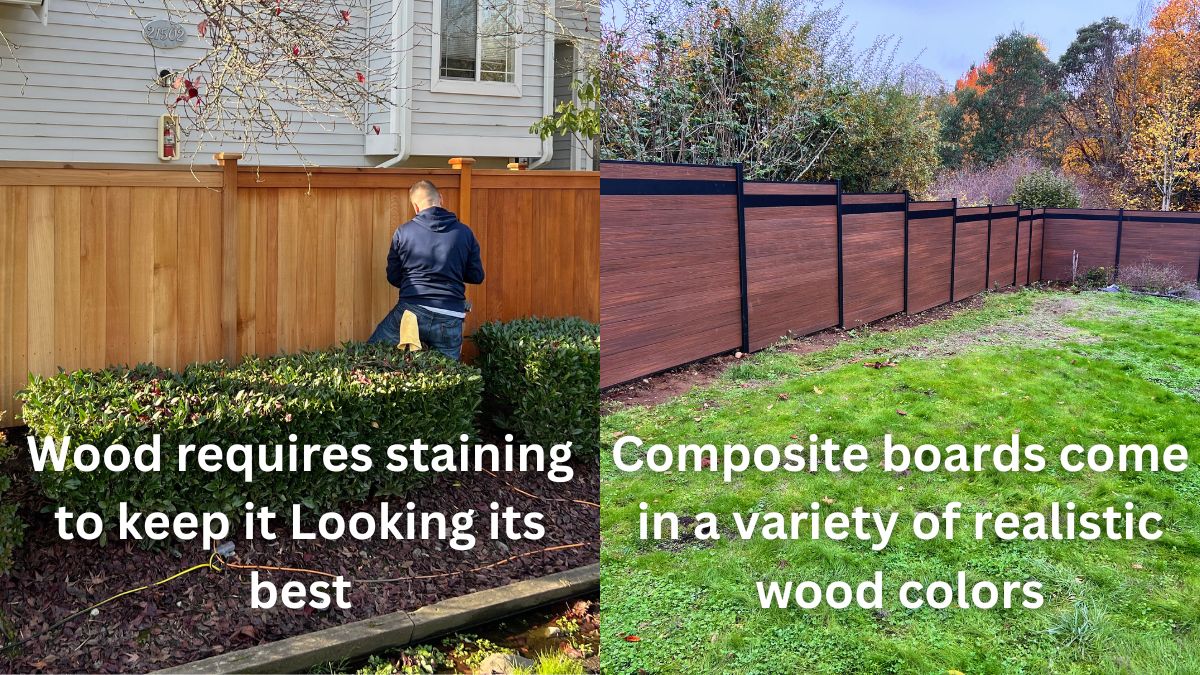
A significant difference between composite and wood fencing is their respective maintenance requirements. While wooden fences require regular upkeep to maintain their appearance and durability, composite fences are designed to stand the test of time with minimal maintenance.
Cleaning
When it comes to cleaning, both composite and wood fences need regular attention. However, composite fencing usually requires nothing more than a simple wash-down with water, while wooden fences may need more extensive cleaning methods to preserve their appearance and longevity.
Painting and Staining
One area where composite fencing shines is in its need (or lack thereof) for painting or staining. Unlike wood fences, which often need regular painting or staining to maintain their appearance, composite fences retain their color and finish for years, with no need for additional treatments.
Repairs
In terms of repairs, composite fencing comes out ahead once again. Owing to its durability and resistance to weather and pests, composite fences generally require fewer repairs than wooden fences.
Aesthetics and Design Options
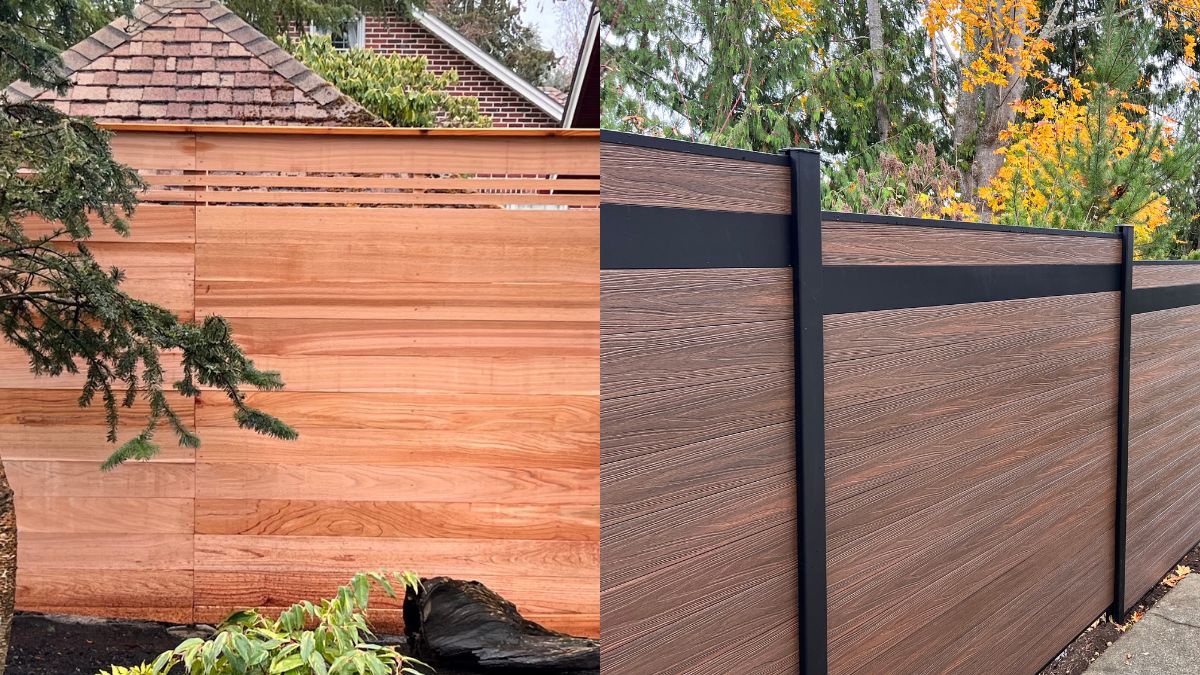
Side-by-side comparison of western red cedar wood fence and Infinity Euro composite fence
The visual appeal of fencing is just as critical as its functionality. Both composite and wood fencing offer unique aesthetic appeal and design options.
Composite fencing offers a modern, sleek appearance, while wood fencing provides a traditional, natural look.
Visual Appeal
Composite fencing, with its clean lines and uniform color, adds a modern touch to any outdoor space, making it a great alternative to traditional vinyl fence options.
On the other hand, wood fencing, with its unique grain patterns and natural variations, exudes a classic, rustic charm that resonates with many homeowners seeking a particular fence style, as opposed to their wood counterparts.
Design Options
When it comes to design options, both materials shine. Composite fencing comes in various colors and styles, offering a range of modern visual aesthetics.
Wood fencing, on the other hand, boasts unmatched design flexibility due to its natural properties.
Environmental Impact: Composite vs Wood Fence
With growing environmental consciousness, our choice of fencing materials acquires crucial significance. Composite fencing, made from recycled materials, has a lower environmental impact than wood fencing, which can contribute to deforestation.
Material Sourcing
Composite fencing is made from a blend of recycled wood fibers and plastic, often sourced from recycled content like plastic milk cartons and grocery bags. This use of recycled materials not only gives composite fencing its strength but also contributes to waste reduction.
On the other hand, wood fencing often requires the cutting of trees, contributing to deforestation.
Recycling Potential
At the end of their lifespan, composite fences can be recycled, giving them a second life in new products. Wood fences, on the other hand, often end up in landfills, where they contribute to methane production—a potent greenhouse gas.
Carbon Footprint
In terms of carbon footprint, composite fencing comes out ahead. Its advantages include:
- Less energy-intensive manufacturing process
- Fewer greenhouse gas emissions compared to wood products
- Use of recycled materials in production further reduces carbon footprint.
Installation Process: Comparing Ease and Time Required
Installation can be a major aspect of a fencing project, with ease and speed being deciding factors in choosing between composite and wood fencing.
Composite fencing, with its pre-assembled sections and lighter weight, generally offers a faster and easier installation process than a traditional composite fence.
Weight
The weight of your fencing material can significantly impact the ease of installation. Composite fencing, being lighter than wood fencing, is easier to handle and install, saving you time and effort during the installation process.
Tools and Equipment
When it comes to installation tools and equipment, composite fencing may require some special tools and know-how. In contrast, wood fencing can be installed with standard tools, making it a more accessible option for DIY enthusiasts.
Time Required
If time is of the essence, composite fencing might be your best bet. Thanks to its pre-assembled panels and lighter weight, the installation process is typically faster than that of wood fencing.
Summary
Choosing between composite and wood fencing can be a complex decision, but understanding their differences can make the task a lot easier. While wood fencing offers a classic, natural look and design flexibility, composite fencing shines in terms of durability, maintenance requirements, and environmental impact. Whatever your preference, your choice of fencing material will affect not only the aesthetics of your outdoor space but also its long-term value and your environmental footprint.
Frequently Asked Questions
Are composite fences better than wood?
Composite fences are generally better than wood due to requiring less maintenance, having a longer lifespan, and being resistant to rot and decay. Wood fences, on the other hand, are cheaper initially but need more upkeep.
What are the disadvantages of composite fencing?
Composite fencing has the disadvantages of being less commonly used than aluminum fencing, having a higher initial cost compared to vinyl and softwood fencing, and being less flexible than wrought iron fencing. Consider these factors before choosing composite fencing for your project.
Is a composite fence more expensive than a wood fence?
Yes, a composite fence is generally more expensive than a wood fence, with wood fences costing around $15 per foot and composite wood fences costing $25 per foot or more.
What is the life expectancy of a composite fence?
Composite fencing typically has a life expectancy of 30 to 50 years, making it a durable option for your property.
What materials are used in composite fencing?
Composite fencing is made from a mix of recycled wood fibers and plastic, which gives it strength and longevity.

